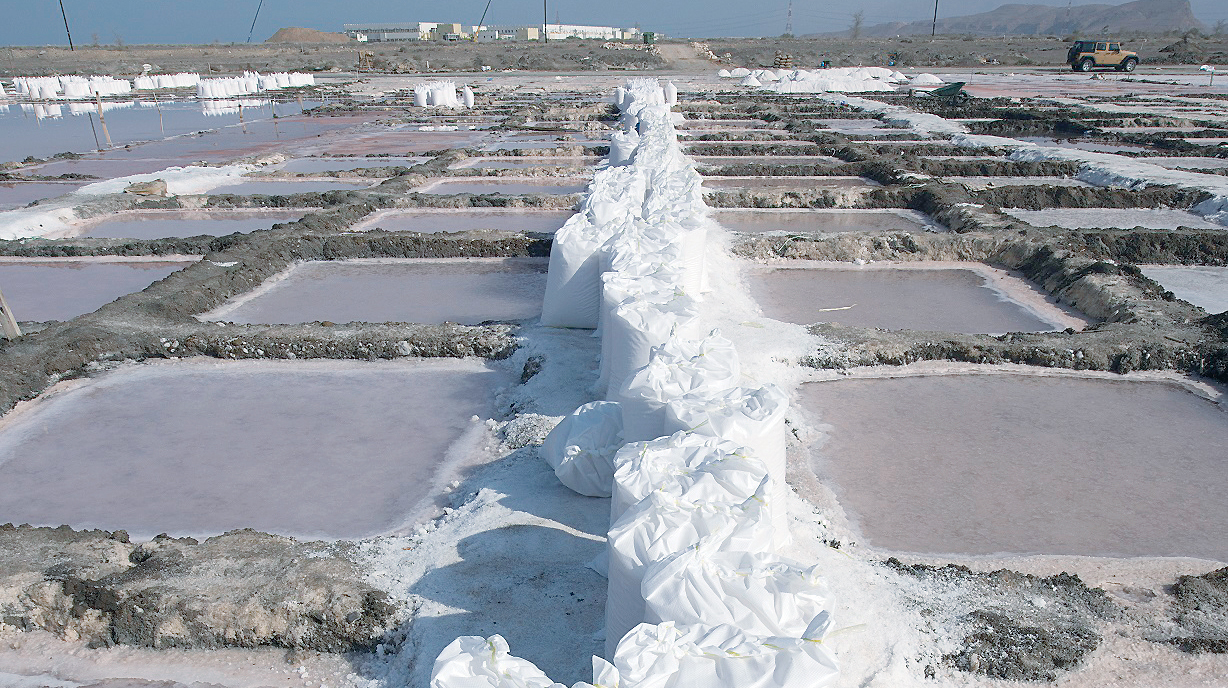

Khoor Al Malh, which literally means the wetland of salt, is ranked one of the rare environmental sites in the Sultanate. Khoor Al Malh is located approximately 7 kilometres from the main road which leads to Wilayat of Qurayat towards the coastal village of Daghmar. Khoor Al Malh is blessed with natural salt pans or salt flats. The collected salt water collected in artificial ponds undergoes natural evaporation by exposure to the sun. This process allows salt water to evaporate easily and then the salt is deposited on the surface of the ponds. The salt is then dried, purified and stored in either bags made of fiber palm trees or plastic bags.
The process of manufacturing salt takes around 7 to 10 days. People say that the best times to make the natural salt industry is during the summer season, when the temperature reaches its peaks. Salt is sold mainly in Qurayat and Muttrah markets. Each bag weighs about 30 to 40 kg and each single bag is sold in a very cheap price for about one and a half riyals. Around 500 locals work in this traditional industry. ”We inherit this tradition from our parents and grandparents. To date, we still rely on this remarkable industry to ensure our livelihoods”, Saleh al Farsi, an Omani researcher, told the Observer.
The Ministry of Housing recently has extended the total area of the site, so the locals can invest and benefit from the salt harvest as much as possible. The profession of salt collection and purification is the main source of income for many people. The monthly income per person of this business
is RO 300-600. “We thank the Ministry of Housing for this initiative, which undoubtedly contributes to the support of the local product and provides employment opportunities suitable for the residents of this region. It also contributes to preserving part of the cultural heritage of the coastal village of Daghmar”, an investor told the Observer.
Salt sources and basins are divided into lines. Each stock has 4 lines with 40 basins per line, so each line has 10 salt basins. Each line is owned by a person or sometime two. Investors confirm that each section of this site has its own name. All names reflect the Omani culture. So, they called their basins: Sanghoor, Malkoot, Al Safa, Al Jawari, Al Wadi. In the past, “people used to rely on animals (camels / donkeys) or small boats to transport their goods to markets, namely the Qurayat market which is situated around 10 km from the site. Decades ago, they were exporting the surplus production to a number of neighbouring countries, specifically Africa and India via the commercial ships,” Al Farsi said.
Historically, archaeological studies confirm that civilisation existed near this region dating back to the fourth millennium BC. Therefore, this site is ranked as one of the oldest archaeological sites in Qurayat. To this day, Omanis use salt in many industries, including salting fish, purifying water, leather tanning, and many traditional medicines. There is a belief among people that salt chases evil and envy, nullifies magic, and brings good luck.
Text & photos by Yahya Al Salmani
Oman Observer is now on the WhatsApp channel. Click here



